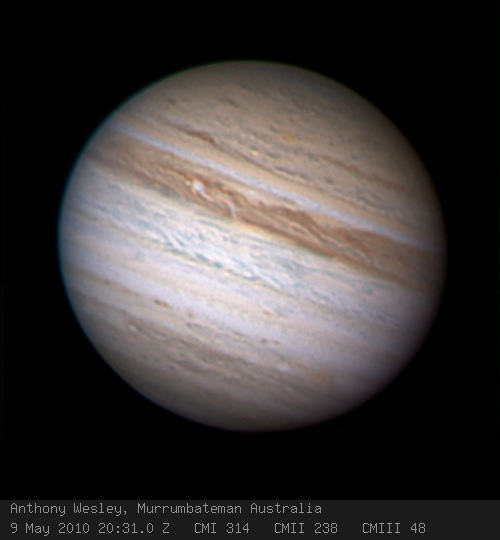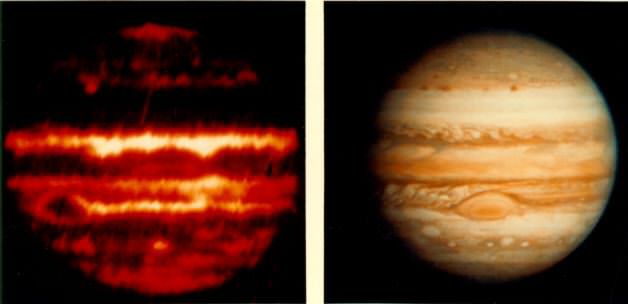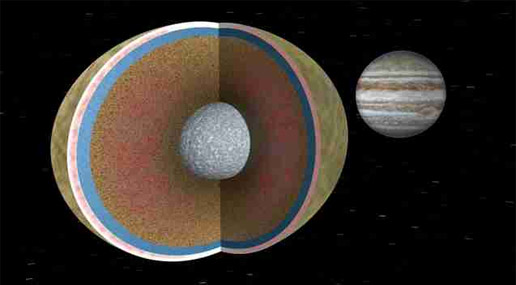It looks like once again, Jupiter has taken a hit! And once again an amateur astronomer spotted and captured the event. Masayuki Tachikawa was observing Jupiter on at 18:22 Universal Time on August 20th (early on August 21 in Japan) and his video camera captured a 1-second-long flash on the planet’s disk, along the northern edge of the gas giant’s North Equatorial Belt. The event was reported by astronomer Junichi Watanabe from the National Astronomical Observatory of Japan, on his blog.
Continue reading “Jupiter Gets Smacked Yet Again?”
Hubble Delves into Two Recent Jupiter Mysteries
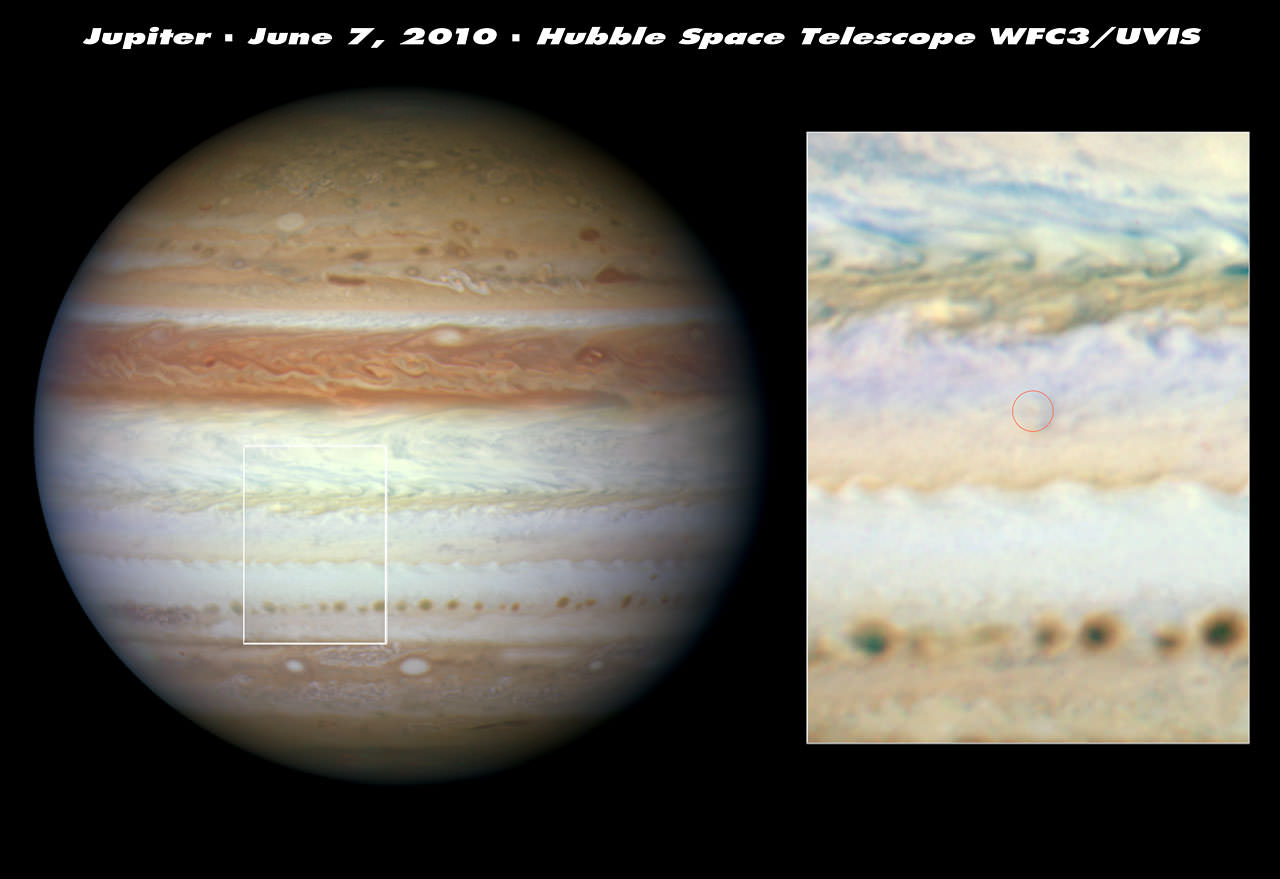
[/caption]
Jupiter has a few mysteries these days. Between an equatorial belt that has gone missing and an impact that didn’t leave a mark, astronomers decided they needed to put the Hubble Space Telescope on the case. New and detailed observations from the venerable space telescope have provided some insights into these two recent puzzling events.
At 22:31 (CEST) on June 3, 2010 Australian amateur astronomer Anthony Wesley saw a two-second-long flash of light on the disc of Jupiter, captured from a live video feed from his telescope. In the Philippines, amateur astronomer Chris Go confirmed that he had simultaneously recorded the transitory event on video. Wesley was also the discoverer of the now world-famous July 2009 impact.
Astronomers around the world suspected that something significant must have hit the giant planet to unleash a flash of energy bright enough to be seen here on Earth, about 770 million kilometers away. But they didn’t know how just how big it was or how deeply it had penetrated into the atmosphere. Over the past two weeks there have been ongoing searches for the “black-eye” pattern of a deep direct hit like those left by former impactors.
Astronomers turned Hubble’s Wide Field Camera 3 aboard the NASA/ESA Hubble Space Telescope on June 7, and found no sign of debris above Jupiter’s cloud tops. This means that the object didn’t descend beneath the clouds and explode as a fireball. If it had, then dark sooty blast debris would have been ejected and would have rained down onto the clouds.
Instead the flash is thought to have come from a giant meteor burning up high above Jupiter’s cloud tops, which did not plunge deep enough into the atmosphere to explode and leave behind any telltale cloud of debris, as seen in previous Jupiter collisions.
“The cloud tops and the impact site would have appeared dark in the ultraviolet and visible images due to debris from an explosion,” said team member Heidi Hammel of the Space Science Institute in Boulder, Colorado. “We can see no feature that has those distinguishing characteristics in the known vicinity of the impact, suggesting there was no major explosion and no ‘fireball’.”
Dark smudges marred Jupiter’s atmosphere when a series of fragments of Comet Shoemaker-Levy 9 hit Jupiter in July 1994, and a similar dark area formed in July 2009 when a suspected asteroid slammed into Jupiter. The latest intruder is estimated to be only a fraction of the size of these previous impactors and is thought to have been a meteor.
So, Wesley and Go were fortunate to have spotted the flash.
“Observations of these impacts provide a window on the past — onto the processes that shaped our Solar System in its early history,” said team member Leigh Fletcher of the University of Oxford, UK. “Comparing the two collisions — from 2009 and 2010 — will hopefully yield insights into the types of impact processes in the outer Solar System, and the physical and chemical response of Jupiter’s atmosphere to these amazing events.”

Since Hubble was now trained on Jupiter, astronomers used the opportunity to get a close-up look at changes in Jupiter’s atmosphere following the disappearance of the dark cloud feature known as the Southern Equatorial Belt several months ago.
In the Hubble view, a slightly higher altitude layer of white ammonia ice crystal clouds appears to obscure the deeper, darker belt clouds. “Weather forecast for Jupiter’s Southern Equatorial Belt: cloudy with a chance of ammonia,” Hammel said.
The team predicts that these ammonia clouds should clear out in a few months, as they have done in the past. The clearing of the ammonia cloud layer should begin with a number of dark spots like those seen by Hubble along the boundary of the south tropical zone.
“The Hubble images tell us these spots are holes resulting from localized downdrafts. We often see these types of holes when a change is about to occur,” said Amy Simon-Miller from Goddard Space Flight Center. .
“The Southern Equatorial Belt last faded in the early 1970s. We haven’t been able to study this phenomenon at this level of detail before,” Simon-Miller added. “The changes of the last few years are adding to an extraordinary database on dramatic cloud changes on Jupiter.”
Source: ESA’s Hubble website
New Hubble Images Zoom In on Asteroid Impact on Jupiter
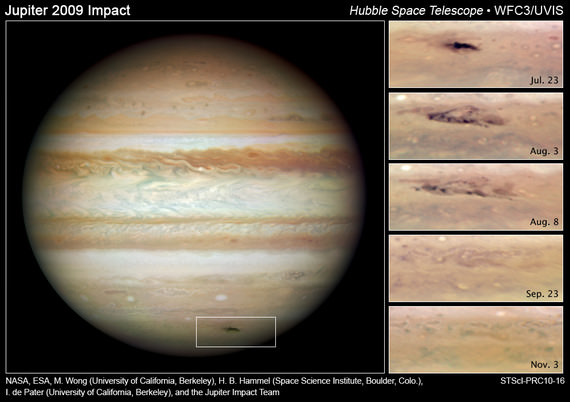
[/caption]
When amateur astronomer Anthony Wesley from Australia saw a dark spot the size of the Pacific Ocean appear on Jupiter through his telescope on July 19, 2009, this started a flurry of astronomic activity, with other telescopes quickly slewing to take a look. It didn’t take long for other astronomers to confirm Jupiter had been hit by an object, either an asteroid or a comet. Of course, the world’s most famous telescope, Hubble, zeroed in on this unexpected activity on Jupiter, and luckily, the telescope had been recently updated with a new Wide Field Camera 3 and newly repaired Advanced Camera for Surveys. Astronomers have now released a series of images from Hubble which may show for the first time the immediate aftermath of an asteroid striking another planet.
Astronomers have witnessed this kind of cosmic event before, but from a comet. Similar scars had been left behind during the course of a week in July 1994, when more than 20 pieces of Comet P/Shoemaker-Levy 9 (SL9) plunged into Jupiter’s atmosphere. The 2009 impact occurred during the same week, 15 years later.
But comparing Hubble images of both collisions, astronomers say the culprit was likely an asteroid about 1,600 feet (500 meters) wide.

Source: Hubblesite.org
“This solitary event caught us by surprise, and we can only see the aftermath of the impact, but fortunately we do have the 1994 Hubble observations that captured the full range of impact phenomena, including the nature of the objects from pre-impact observations” says astronomer Heidi Hammel of the Space Science Institute in Boulder, Colo., leader of the Jupiter impact study.
The analysis revealed key differences between the two collisions (in 1994 and 2009), providing clues to the 2009 event. Astronomers saw a distinct halo around the 1994 impact sites in Hubble ultraviolet (UV) images, evidence of fine dust arising from a comet-fragment strike. The UV images also showed a strong contrast between impact-generated debris and Jupiter’s clouds.
Hubble ultraviolet images of the 2009 impact showed no halo and also revealed that the site’s contrast faded rapidly. Both clues suggest a lack of lightweight particles, providing circumstantial evidence for an impact by a solid asteroid rather than a dusty comet.
The elongated shape of the recent asteroid impact site also differs from the 1994 strike, indicating that the 2009 object descended from a shallower angle than the SL9 fragments. The 2009 body also came from a different direction than the SL9 pieces.

Source: Hubblesite.org
Team member Agustin Sanchez-Lavega of the University of the Basque Country in Bilbao, Spain, and colleagues performed an analysis of possible orbits that the 2009 impacting body could have taken to collide with Jupiter. Their work indicates the object probably came from the Hilda family of bodies, a secondary asteroid belt consisting of more than 1,100 asteroids orbiting near Jupiter.
The 2009 strike was equal to a few thousand standard nuclear bombs exploding, comparable to the blasts from the medium-sized fragments of SL9. The largest of those fragments created explosions that were many times more powerful than the world’s entire nuclear arsenal blowing up at once.
The recent impact underscores the important work performed by amateur astronomers. “This event beautifully illustrates how amateur and professional astronomers can work together,” said Hammel.
The Jupiter bombardments reveal that the solar system is a rambunctious place, where unpredictable events may occur more frequently than first thought. Jupiter impacts were expected to occur every few hundred to few thousand years. Although there are surveys to catalogue asteroids, many small bodies may still go unnoticed and show up anytime to wreak havoc.
The study by Hammel’s team appeared in the June 1 issue of The Astrophysical Journal Letters.
Science Paper by: Hammel et al. (PDF document)
Source: HubbleSite
How Many Earths Can Fit in Jupiter?
Jupiter is known as the “King of the Planets”, and for good reason. For one, it is the largest planet in the Solar System, and is actually more massive than all the other planets combined. Fittingly, it is named after the king of the Roman pantheon, the latinized version of Zeus (the king of the Olympian gods).
Compare that to Earth, which is the largest of the terrestrial planets, but a tiny marble when compared to the Jovian giant. Because their disparity in size, people often wonder many times over Earth could be squeezed in Jupiter’s massive frame. As it turns out, you could it do many, many times over!
Size and Mass Comparison:
To break the whole size discrepancy down, Jupiter has a mean radius of 69,911 ± 6 km (60217.7 ± 3.7 mi). As already noted, this is roughly 2.5 times the mass of all the planets in the Solar System combined. Compared this to Earth’s mean radius of 6,371.0 km (3,958.8 mi), and you could say that Earth fits into Jupiter almost 11 times over (10.97 to be exact).
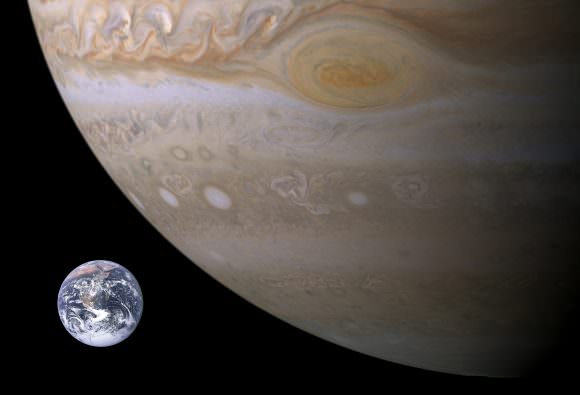
And as already noted, Jupiter is more massive than all the other planets in our Solar System – 2.5 times as massive, that is. In fact, Jupiter weighs in at a hefty 1.8986 × 1027 kg (~4.1857 x 1027 lbs), or 1898.6 billion trillion metric tons (2.092 billion trillion US tons).
Compare that to Earth, which has a mass of 5.97 × 1024 kg (13.1668 × 1024 lb) – 5.97 billion trillion metric tons, or 6.5834 billion trillion US tons. Doing the math, we then come to the conclusion that Jupiter is approximately 317.8 times as massive as Earth.
Volume Comparison:
However, figuring for radius is only useful is you are planning on stacking the Earths end to end across the middle of the gas giant. And comparing their masses doesn’t give you a sense of size, seeing as how the planets are widely different in terms of their density.

To know how many Earth’s could truly fit inside in three-dimensions, you have to consider total volume, which you can calculate using the simple formula of 4/3 x Pi x radius2.
Doing the math, we find that Jupiter has a volume of 1.43 x 1015 km³ (1,430 trillion cubic km; 343 trillion cubic mi) while Earth has a volume of 1.08 trillion km3 (259 million mi). Divide the one by the other, and you get a value of 1299, meaning you could fit almost 1300 Earth’s inside Jupiter.
In short, the king of the planets is much, much, MUCH bigger than the planet we call home. Someday, if we ever hope to live around Jupiter (i.e. colonize its moons), we will be able to appreciate just how big it is up close. Until then, these impressive figures will have to suffice!
We’ve written many articles about Jupiter for Universe Today. Here’s Ten Interesting Facts About Jupiter, Jupiter Compared to Earth, What is the Diameter of Jupiter?, and How Much Bigger is Jupiter than Earth?
If you’d like more information on Jupiter, check out Hubblesite’s News Releases about Jupiter, and here’s a link to NASA’s Solar System Exploration Guide to Jupiter.
We’ve also recorded an episode of Astronomy Cast just about Jupiter. Listen here, Episode 56: Jupiter.
Sources:
Jupiter, It Is A-Changing
[/caption]
Jupiter’s appearance has changed dramatically since the end of 2009, when it moved too close to the Sun from our vantage point on Earth to be observed. New looks at the planet after it emerged from the Sun’s glare reveals that one of the bands of clouds, the South Equatorial Belt, has gone missing. This image from amateur astronomer Anthony Wesley (the same astronomer who captured an impact spot on Jupiter last year) taken on May 9, 2010, shows a rather undressed Jupiter without its usually prominent southern band. See a comparison of earlier images below.
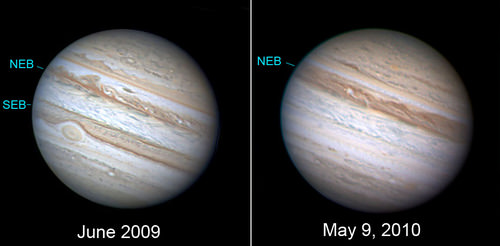
What caused the disappearance of the band? Astronomers aren’t sure, but this isn’t the first time this has happened. Back in 1973 when the Pioneer 10 spacecraft flew by and took the first close-up images of the planet, the southern band was missing, and it also disappeared in the early 1990s. Also, in 2007 cloud bands around its equator that had been light-colored for the past 15 years or so were noticeably darker.
Emily at the Planetary Society has written about this, and so has amateur astronomer Bob King, a.k.a “Astro Bob,” who explains:
“Every 3-15 years, the belt, which is normally dark reddish-brown in color and typically divided in two by the south equatorial belt zone, fades from view. After some weeks or months a brilliant white spot forms within that zone and begins spouting dark blobs of material which get stretched into filaments and ovals by Jupiter’s fierce winds into a new SEB. Within a few weeks (or longer) the belt is back and Jupiter presents its familiar dual “tire track” appearance through a telescope.”
Check out Anthony Wesley’s gallery of Jupiter images, and watch for new images over the next days and months to monitor the changes. Surely, Hubble and other observatories will be making new observations, as well.
Thanks to Anthony Wesley for sharing his images.
New Images Unlock Secrets of Jupiter’s Red Spot

It’s difficult enough to track the weather on Earth, but with new thermal images of Jupiter’s Great Red Spot, scientists now have the first detailed interior weather map of a giant storm system on another planet. “This is our first detailed look inside the biggest storm of the solar system,” said Glenn Orton, a senior research scientist at NASA’s Jet Propulsion Laboratory. “We once thought the Great Red Spot was a plain old oval without much structure, but these new results show that it is, in fact, extremely complicated.”
Continue reading “New Images Unlock Secrets of Jupiter’s Red Spot”
One of Jupiter’s Moons is Melted!

[/caption]
Jupiter’s two moons Ganymede and Callisto could be considered fraternal twins. They have a similar composition and size, but visually, they are different. Also, data from the Galileo and Voyager spacecraft reveal the two moons’ interiors are very dissimilar, as well. The reasons for the differences have eluded scientists for 30 years, but a new study provides an explanation. During the Late Heavy Bombardment, Callisto escaped relatively unscathed, while Ganymede was a battered child; so much so that the later moon melted. “Impacts during this period melted Ganymede so thoroughly and deeply that the heat could not be quickly removed,” said Dr. Amy Barr of the Southwest Research Institute. “All of Ganymede’s rock sank to its center the same way that all the chocolate chips sink to the bottom of a melted carton of ice cream. Callisto received fewer impacts at lower velocities and avoided complete melting.”
Barr and and Dr. Robin Canup created a model showing how Jupiter’s strong gravity focused cometary impactors onto Ganymede and Callisto 3.8 billion years ago, during the LHB period. Each impact onto Ganymede or Callisto’s mixed ice and rock surface creates a pool of liquid water, allowing rock in the melt pool to sink to the moon’s center.
But Ganymede is closer to Jupiter and therefore was hit by twice as many icy impactors as Callisto. Additionally, the impactors hitting Ganymede had a higher average velocity. Modeling by Barr and Canup shows that core formation begun during the late heavy bombardment becomes energetically self-sustaining in Ganymede but not Callisto.

Watch a movie that shows the effect of an outer solar system late heavy bombardment on the interior structure of Callisto (top model in the movie) and Ganymede (bottom).
“Similar to Earth and Venus, Ganymede and Callisto are twins, and understanding how they were born the same and grew up to be so different is of tremendous interest to planetary scientists,” explains Barr. “Our study shows that Ganymede and Callisto record the fingerprints of the early evolution of the solar system, which is very exciting and not at all expected.”
The “Ganymede-Callisto dichotomy,” has been a classical problem in comparative planetology, a field of study that seeks to explain why some solar system objects with similar bulk characteristics have radically different appearances. The study by Barr and Canup also links the evolution of Jupiter’s moons to the orbital migration of the outer planets and the bombardment history of Earth’s moon.
Source: SwRI
How Hot is Jupiter?
[/caption]
Given how far Jupiter is from the Sun, you might think that “how cold is Jupiter?” would be a more relevant question and you would be partially right. “How hot is Jupiter?” becomes more relevant the deeper into the planet’s atmosphere and core that you travel. Near the very center of the planet, scientists believe that temperatures can reach 35,500 C.
The outer edges of Jupiter’s atmosphere are much cooler than the core region. Temperatures in the atmosphere are thought to be as cold as -145 degrees C. The intense atmospheric pressure on Jupiter contributes to temperature increases as you descend. Not far into the atmosphere the pressure can be ten times what it is here on Earth and scientists speculate that the temperature is 20 degrees C(average room temperature on Earth). A few hundred km deeper into the planet and hydrogen becomes hot enough to turn into a liquid. The temperature at this point is believed to be over 9,700 C. The layer of dense molten hydrogen metal extends to the 78th percentile of the planet’s radius. Between the cold clouds and the molten lower regions is an interior atmosphere of hydrogen. The hydrogen in this region is at a temperature where there are no distinct liquid and gas phases, so the hydrogen is said to be in a supercritical fluid state.
The molten inner regions of the planet serve to heat the rest of the planet through convection, so Jupiter gives off more heat than it receives from the Sun. This heating prevents it from being an ice giant instead of a gas giant, but wreaks havoc in the atmosphere. Storms and high winds are generated by cool air and warm air mixing here on Earth. Scientist think that the same holds true on Jupiter. The Galileo spacecraft observed winds in excess of 600 kph. One difference is that the jet streams that drive storms and winds on Earth are caused by the Sun heating the atmosphere. On Jupiter it seems that the jet streams are driven by the planets’ own heat. Storms on Jupiter are as out-sized as the planet. The Great Red Spot is a single storm that has been raging for hundreds of years. Other storms have been observed to grow to more than 2,000 km in diameter in a single day.
“How hot is Jupiter?” is more relevant than you may have thought. The planet’s inner heat seems to be the basis for its identity as a stormy world. The actual temperatures of the different areas of the planet may not be a mystery much longer. Hopefully, the recently launched JUNO space mission will clear up many of the Jovian theories that scientists currently have.
We’ve written many articles about the temperature of planets for Universe Today. Here’s an article about how hot Mercury is, and here’s an article about how hot Venus is.
If you’d like more information on Jupiter, check out Hubblesite’s News Releases about Jupiter, and here’s a link to NASA’s Solar System Exploration Guide to Jupiter.
We’ve also recorded an episode of Astronomy Cast just about Jupiter. Listen here, Episode 56: Jupiter.
Sources:
http://solarsystem.nasa.gov/planets/profile.cfm?Object=Jupiter
http://www.nasa.gov/mission_pages/juno/main/index.html
Jupiter’s Core
Jupiter probably does not have a solid core. Jupiter’s core contains some rock and hydrogen metals. Scientists can not be 100 percent certain if deep within the planet there is a solid core or not, but based on gravitational measurements compared with Earth’s, the best educated guesses possible based on those measurements say there is no solid core. Those measurements make them think that the core is a thick, super hot soup.
Jupiter’s composition is more of a mystery than anything else. The accepted theory holds that it consists of a dense core made of a mixture of elements, the core is thought to be surrounded by a layer of liquid metallic hydrogen and helium, then the outer layer is to be dominated by molecular hydrogen. The core is often speculated to be rocky. It wasn’t until 1997 that the existence of the core was even theorized. Gravitational measurements were taken, indicating a mass in the neighborhood of 12 to 45 times the Earth’s mass, so the proposed core accounts for about 3–15% of the total mass of the planet. The presence of a planetary core follows accepted knowledge of planetary formation. According to this knowledge base, Jupiter would have had to form a rocky or icy core with enough mass in order to capture such a high percentage of gasses from the early solar nebula. Scientists admit that the planet may lack a core at this time due to the high heat and as hot liquid metallic hydrogen mixed with the molten core, carrying it to higher levels of the planet’s interior.
The layer of dense molten hydrogen metal extends to the 78th percentile of the planet’s radius. Just above the layer of metallic hydrogen is an interior atmosphere of hydrogen. The hydrogen at this point is at a temperature where there are no distinct liquid and gas phases, so the hydrogen is in a supercritical fluid state. The temperature and pressure increase steadily toward the core. In the region where hydrogen becomes metallic, the temperatures are thought to be up to 10,000 K and the pressure is 200GPa. The temperature at the core boundary is estimated to be 36,000 K and the pressure is believed to be 3,000 to 4,500 Gpa.
Since very little is known about the composition of Jupiter’s core or even if it still exists, the JUNO space mission was launched on August of 2011. It should arrive in orbit around Jupiter in 2016. The purpose of the mission is to orbit the poles and clear up some of the mysteries surrounding the planet and the entire Jovian system.
We’ve written several articles about planetary cores for Universe Today. Here’s an article about the Earth’s core, and here’s an article about the core of Mercury.
If you’d like more information on Jupiter, check out Hubblesite’s News Releases about Jupiter, and here’s a link to NASA’s Solar System Exploration Guide to Jupiter.
We’ve also recorded an episode of Astronomy Cast all about Jupiter. Listen here, Episode 56: Jupiter.
Source: NASA
Weight on Jupiter
[/caption]
If you are worried about your weight, do not go to Jupiter. The Jovian gravity is much more intense than Earth’s. 2.528 times more intense to be exact. That means if you weigh 100 kg on Earth, your weight on Jupiter would be 252.8 kg.
Of course, you can not stand on the surface of Jupiter. Jupiter is composed of about 90% hydrogen and 9.99% helium. The gaseous nature of the planet makes a solid surface impossible. Scientists have devised a way to define the surface of Jupiter, though. The surface of the planet is defined as the point where the pressure of the atmosphere is 1 bar, which is equal to the atmospheric pressure at Earth’s surface. That point is at the tops of Jupiter’s clouds.
Now that we have defined your weight on Jupiter, let’s move to on some other interesting facts about the planet. To start off, even though it is the largest planet in our Solar System, it is not the largest planet that we know of. While there are several planets larger than Jupiter, the largest known to man is TrES-4. TrES-4 is 70% larger than Jupiter, but is quite a bit less massive. Scientists think that it has a structure similar to cotton candy for lack of a better analogy.
Since Jupiter’s gravity is so intense, it has trapped quite a few moons. The are 63 acknowledged Jovian moons and there are a few others being studied, so that number could go up at any time.
Jupiter has a system of rings. Many people are surprised to find out that Saturn is not the only ringed planet in our Solar System. In addition to Saturn; Jupiter, Uranus, and Neptune have rings. Rings are generally formed by dust and debris left orbiting after a meteorite impact on a moon. With so many moons, you would think that Jupiter would have a bunch of rings. It only has four defined rings, though.
A day on Jupiter is just under 10 Earth hours long, but a single years lasts 11.86 Earth years.
Some scientists think that Jupiter’s gravity is intense enough to affect the Sun. They believe that when Jupiter is at its closest approach to the Sun, solar flare activity increases. Others believe that Jupiter’s gravity may eventually push Mercury our of our Solar System.
Now that you know what your weight on Jupiter would be, we hope that you will want to research more Jovian facts.
We’ve written several articles about your weight on other planets. Here’s an article about your weight on the Moon, and here’s a link about your weight on Mercury.
If you’d like more information on Jupiter, check out Hubblesite’s News Releases about Jupiter, and here’s a link to NASA’s Solar System Exploration Guide to Jupiter.
We’ve also recorded an episode of Astronomy Cast just about Jupiter. Listen here, Episode 56: Jupiter.
Source: NASA


